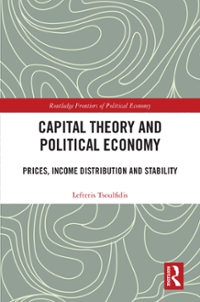Question
Consider the following model of housing using a simple exchange economy. Suppose there are two tradeable goods: money m, and housing h. Agents may also
Consider the following model of housing using a simple exchange economy. Suppose there are two tradeable goods: money m, and housing h. Agents may also derive utility from a non-tradeable good, their superannuations. All agents i in the economy have the utility function
ui(m, h) = ln(m) + h + ln(si)
As superannuation s is not tradeable, it has not been included as a choice variable. It will never have a 'price' attached to it. It simply adds to utility if the agent has it and doesn't if they don't.
Suppose further that there are 100 agents in the economy. Agents 1 to 50 (Type-1 agents) looking to buy a home, and are endowed with i = (10, 0). Agents 51 to 100 (Type-2 Agents) already own homes, and are endowed with j = (5, 2). Assume the price of money is pm = 1.
a) Why can we assume the price of money is 1 in our modelling?
b) What is the Marshallian Demand function xi(p, pi) for the Type-1 agents?
c) What is the Marshallian Demand function xj (p, pj ) for the Type-2 agents?
d) What is the Walrasian Equilibrium in this simple exchange economy? (provide both the equilibrium price and consumed bundles for all agent-types.)
e) Suppose si = 10 for the Type-1 agents, and sj = 10 for the Type-2 agents. What is the utility of the two agent-types in the Walrasian Equilibrium?
Suppose now that the government introduces a new policy, allowing Type-1 agents to "access part of their superannuation". This reduces si to si = 5 for Type-1 agents, and increases the endowment for the Type-1 agents to i = (15, 0).
f) What is the new Walrasian Equilibrium in this simple exchange economy? What is the utility of the two types of agents in equilibrium? How does this compare to the utility prior to the policy change?
The purpose of this model was to investigate an actual government proposed policy to allow renters to access their retirement funds when buying their first property.
g) Describe at most three problems with this specific model as a model to investigate such a policy. For each problem, briefly describe, in words, a potential change to the model to address it.
Step by Step Solution
There are 3 Steps involved in it
Step: 1

Get Instant Access to Expert-Tailored Solutions
See step-by-step solutions with expert insights and AI powered tools for academic success
Step: 2

Step: 3

Ace Your Homework with AI
Get the answers you need in no time with our AI-driven, step-by-step assistance
Get Started


